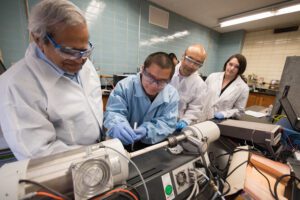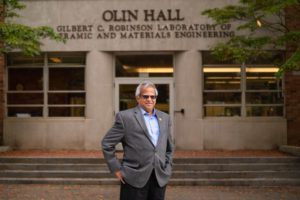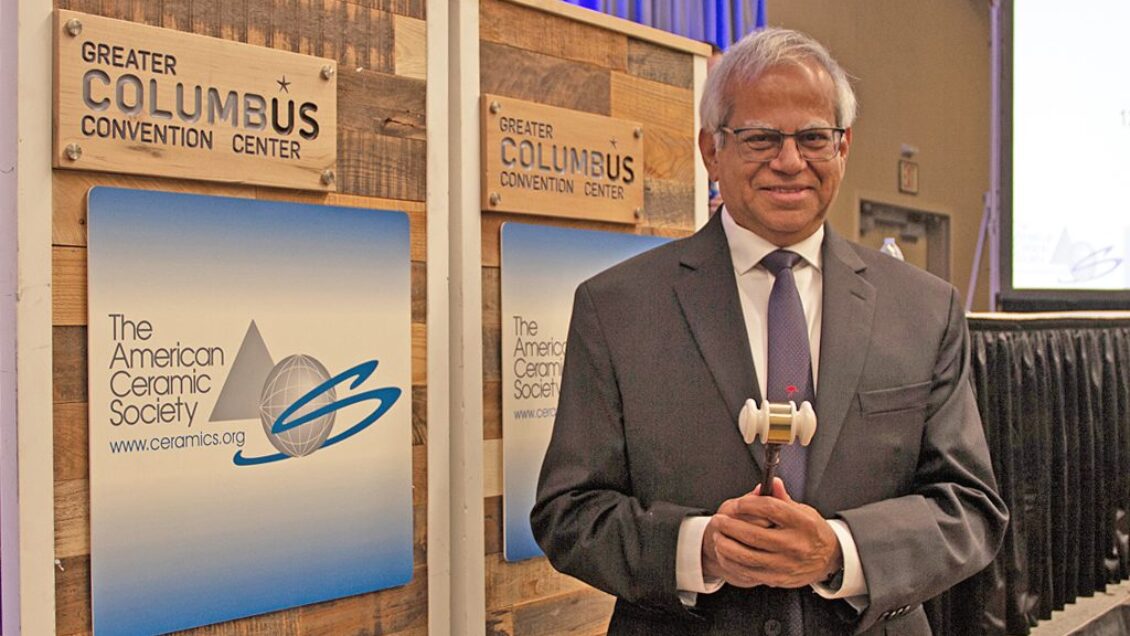Rajendra Bordia accepted a white ceramic gavel in a Columbus, Ohio convention center to start his term as president of The American Ceramic Society, while nearly 500 miles away at Clemson University, construction workers were laying the foundation for the $130-million Advanced Materials Innovation Complex.
The professor, who is a long-time leader in his field and has been on Clemson’s faculty for more than a decade, is putting the University in the spotlight at a pivotal time. His presidency, along with the new building, are significant milestones that underscore the University’s dedication to leadership in advanced materials.

For the next year, Bordia will be president of The American Ceramic Society (ACerS), a global organization that supports leading scientists, engineers, and educators from around the world in the discovery, manufacturing, and use of advanced ceramics and glasses.
Kyle Brinkman, chair of Clemson’s Department of Materials Science and Engineering, congratulated Bordia on his ascension to the president’s seat.
“Raj’s leadership here at Clemson and now globally through his ACerS presidency speaks volumes about his dedication and his impact,” Brinkman said. “This is a proud moment for materials science and engineering at Clemson. Having Raj as president will help spread the word internationally about the big advances happening here.”
Congratulations also came from Anand Gramopadhye, dean of the College of Engineering, Computing and Applied Sciences.
“Raj’s presidency at ACerS is a profound testament to his exemplary leadership and vision in the field of advanced materials,” Gramopadhye said. “His service is expanding Clemson’s global impact at a crucial time for the University and South Carolina. I offer my wholehearted congratulations to him on his new role.”
Bordia joined Clemson in 2013 and served for six years as chair of the Department of Materials Science and Engineering. He then accepted the position he holds now, the George J. Bishop III Endowed Chair Professor of Ceramics and Materials Engineering.
Bordia is taking the helm of ACerS as it begins its 126th year. In an interview, he described what he thinks his presidency will mean for Clemson, laid out his vision for the Society, and described the transformational role ceramics are playing in new technologies.

What do you think your presidency will mean for Clemson, particularly now as the University makes bold moves in advanced materials?
It’s an exciting time to be a materials scientist here at Clemson. Clemson has a long tradition of research and education in ceramics going back more than 75 years. As a result, we have many alumni of the department, including several in industry, that have a connection to The American Ceramic Society. I think they will look at the fact that a professor from Clemson is the president quite favorably, and I hope they will engage more deeply and meaningfully with Clemson and our department.
The presidency of The American Ceramic Society is an unpaid volunteer position that is sure to keep you busy. Why is it a job you wanted?
I gave my first technical talk at an American Ceramic Society meeting when I was in the early stages of my Ph.D. over 40 years ago. Since then, it has been my primary professional Society, and I’ve remained deeply engaged with it. It has provided me with great mentors, a wonderful set of friends and collaborators and significant opportunities for professional development and growth. I am thankful to the Society and have thoroughly enjoyed being a part of it. Being a volunteer leader is my way of giving back.
Before we get into your plans, can you give us a good layperson’s definition of what ceramics are?
There is a very simple definition for ceramics that I use. Ceramics are non-metallic, inorganic materials. Take out all metals, polymers, and organic materials, including biological soft materials, and what you have left are ceramics.
What is your vision for The American Ceramic Society?

This is a very old Society, continuously serving the professional needs of its members for 125 years. Currently, it serves over 10,000 members from 75 countries. It’s well-established, well-recognized, and highly respected. It has always served ceramic and glass science and engineering, and to some extent even the art community, by providing and sharing technical information, professional development, and networking opportunities. The specific programs have been well thought out, and they continue to work well. Of course, as new people come in, and as I come in as the new president, we will make some changes. But again, the overall mission and vision remain the same. Basically, I want to make sure that the Society serves the needs of its membership at the highest possible level, and for the long-term sustainability and survivability of the Society, I want to capitalize on new opportunities and grow the membership base.
Can you talk about any specific changes?
There are lots of things that we are going to focus on. Specifically, there is a worldwide trend, including in the U.S., to publish research papers as open access. As a result, the business model that the Society has for publications will have to change, and we will proactively work on capitalizing on opportunities that this change provides. In addition, there are many exciting new technology areas in which ceramics play a crucial role, and we will continue to expand the technical scope of the Society in these areas.
The Society has well-recognized and sought-after awards, and leadership and networking opportunities at all professional levels, and we are going to focus on ensuring that we get the most qualified and inclusive nominations for these awards and leadership opportunities.
Finally, there is a vast pool of potential new international members. We have membership from 75 countries. Although the name is The American Ceramic Society, it’s really an international ceramic Society. About 40% of the membership is colleagues who work outside the U.S. We need to make sure that we identify the unique needs of these international members and develop programs and approaches to serve them.
What are some of the most exciting advancements in ceramics today?
This is a wonderful field with lots going on right now. In almost all areas that are high priority both nationally and internationally, ceramics are contributing at a high level and will continue to play an important role. For example, in energy technologies, there’s a significant transition towards clean energy, and ceramics have a huge role to play in this. In solar energy conversion, green hydrogen production, and thermo-mechanical energy conversion, developments in glass and ceramics have and will continue to play a major role. Similarly, ceramics play an important role in almost all batteries. To remove CO2 from the atmosphere and lower emissions in industrial processes, breakthrough advancements in ceramics are happening now. Developments in ceramics and ceramic composites are critically important for advanced aerospace vehicles and nuclear energy conversion. Ceramics also play an important role in sensors, actuators, and electronics for all kinds of applications, including IT, smart devices, robots, and self-driving cars.
The American Ceramic Society also serves the glass community. New developments in glasses are leading the way for lasers, data transmission, fiber optics, and opto-electronics for advanced computing. Finally, significant efforts worldwide focus on the use of glasses and ceramics for biomedical applications, including tissue engineering, drug delivery, and implants.
Is there anything else you’d like to make sure we mention?
I think we covered the most important topics. The American Ceramic Society is a prominent professional Society run by dedicated voluntary leaders and an exceptional group of professional staff. The Society serves its membership well, and there are opportunities to enhance the service members receive while growing the membership base. With support and engagement from members, professional staff, and volunteer leaders, I will work to capitalize on these opportunities.
Get in touch and we will connect you with the author or another expert.
Or email us at news@clemson.edu

